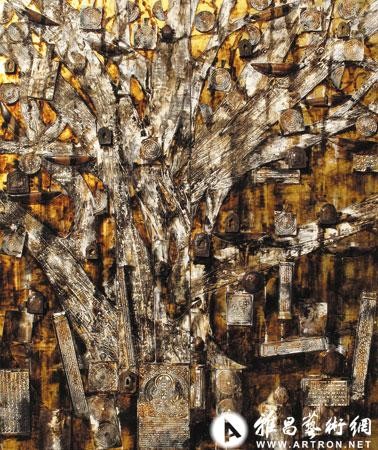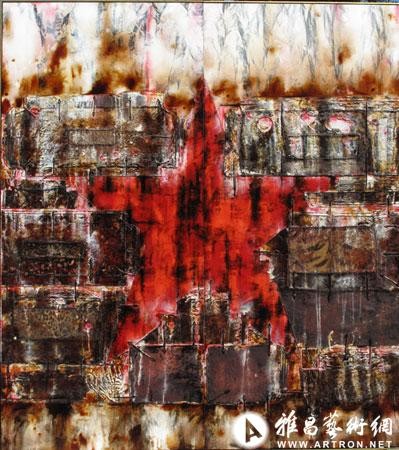分享到微信,
请点击右上角。
再选择[发送朋友]
或[分享到朋友圈]


菩提树 综合材料 220*180cm 2010年作
1984年,美国批评家阿瑟•丹托提出了著名的艺术终结论。当然,丹托说“艺术的终结”并不是说当代艺术无法向前发展,而是说,20世纪现代主义所遵从的那种进化论的、线性发展的、精英主义的、风格至上的叙事原则走向了死亡。当艺术进入后现代阶段后,也就意味着进入到一个新的历史时期。按照丹托的理解,在这个阶段,“艺术家可以真正地做任何事情,似乎任何人都可以成为艺术家”。从这个角度讲,丹托与博伊斯的想法殊途同归。
问题也随之而来。在一个艺术走向终结的时代,绘画何为呢?或者绘画的出路与方向又在哪里?如果说在现代主义时期,绘画有它的传统、规范、原则、信念、边界,但一旦迈入后现代,它们也就自然失效了。20世纪60年代,面对现代主义这个“父亲”,当时的艺术家多少显得战战兢兢,艰辛地探寻着绘画新的可能性。20世纪80年代的时候,中国的前卫艺术家开始向西方学习,模仿、借鉴西方现当代艺术的形式与语汇,这个过程一直持续到了90年代中后期。但是,当中国的艺术家实现了语言学的转向之后,也同样面临着相似的问题,当代绘画还有多少新的可能性?而且,中国的艺术家还需考虑到,如何有效地回应西方现当代艺术带来的冲击,以及与其拉开距离。
当然,中国的当代绘画有它独特的社会文化情景与艺术史叙事逻辑。但“绘画何为”仍然是艺术家无法回避的问题。应该看到,当中国当代绘画在90年代末期完成了语言学的转向后,新世纪的绘画实质也迎来了一个新的时期,创作路径也十分多元:有的从对周遭的社会现实与文化情景入手,有的从个人图式与语言风格的营建出发,有的从艺术史既有的上下文中寻求突破,有的则遵从个人的创作脉络做持续不断的推进。
如何突破既有绘画的形态与边界,如何建立作品的语汇与修辞,如何形成一种新的视觉文本和创作方法论,对于黄钢来说,这些都是他必须关注的问题。但是,从艺术家近十年的创作来看,我们很难对其作品进行简单的界定。因为,它们的创作路径非常多元,风格也较为多样——既有西方现代主义的特征,也有后现代的因子;既有西方的形式结构语汇,又散发出东方传统的表现精神;既有对媒介物性的尊重,又有对图像叙事的依恋;既有对传统文化,尤其是那些弥散出宗教意味的“古物”的喜爱,又表征着当代人对历史、文化的反思,以及对东方文化身份的追问。尽管黄钢的作品具有现代主义的诸多特征,但其作品的意义维度则是多义的,漂移的,弥散的。
黄钢的绘画中始终有一种挥之不去的现代主义情结,而这种情结最直接的体现,就在于他对媒介物性的迷恋,而迷恋的源头则来自于他对收藏的痴迷。他曾说:“我喜爱古物收藏,这种个人的审美趣味对我的创作有很大影响。我在创作中使用大量古老木刻佛经,古老的西藏皮箱,古代的丝织品,甚至五十年前苏联红军皮带的铜扣,我喜欢它们历经时空交错,靠自然与时间之手所创造的表面肌理之美,润泽细腻,让人爱不释手”。
事实上,如果按照美国批评家格林伯格的描述,西方现代主义绘画的源头应肇始于对媒介物性的强调。在他看来,在现代绘画出现之前,既有的艺术史叙事模式是由意大利艺术史史家瓦萨里在16世纪中期建立的。这种叙事性的要义建立在艺术对现实表象世界的征服之上。亦即是说,艺术的发展呈现为图像越来越接近于现实,而艺术的进步则体现在一代一代的画家如何在发展的过程中,将技艺提升到一个更高的层面上。一旦按照这种叙事方法,一部艺术史也就是一部艺术家如何模仿现实,再现现实,征服视觉表象的历史。很显然,针对意大利文艺复兴时期的绘画、雕塑来说,瓦萨里建构的叙事模式是十分有效的。但是,当摄影术发明后,绘画作为视觉表象的呈现方式便遭到了普遍的质疑。因为摄影比绘画更能捕捉表象世界,而且在视觉再现上,照片比绘画更趋近于真实。1839年,当画家保罗•德拉罗什(Paul Delaroche)宣布绘画已经死亡的时候,另外一批现代派的艺术家则尝试将绘画引向一条新的发展路径。到19世纪中期的时候,现代派绘画逐渐背离了被模仿的对象,放弃对视觉表象的呈现,相反,艺术家将作品的意义转嫁到作品内在的形式表达上。于是,“为艺术而艺术”、“唯美主义”的艺术观念开始滥觞,逐渐形成一股艺术思潮,进而发展成为一场影响深远的艺术运动。然而,一旦艺术作品不再将视觉再现的真实与否作为其价值评判的尺度时,这也就意味着,第一种叙事模式必将走向终结。于是,绘画需要建构新的叙事模式。因此,在格林伯格看来,一部现代主义的绘画史,就是现代绘画逐渐分化,回归二维平面,回归媒介,回归艺术本体,走向纯粹的历史。与此同时,艺术家的创作重心开始从对题材、内容的反映转向对形式、本体语言的重视上。这样一来,所谓的现代主义的绘画史,其实就是一部形式风格的发展史。

我的红星--我的箱子 247*220cm 综合材料 2007年作
虽然黄钢非常重视媒介的物性表达,但并不将它们仅仅看作是物理形态上的“物”,而是力图去言说、挖掘媒介背后与生俱来的历史与文化属性。如此一来,黄钢的创作就于西方的现代主义绘画拉开了距离。于是,在《佛经与菩提树》(2004)、《雪域经书》(2005)、《追日》(2007)等作品中,那些饱经沧桑、铭刻着历史印痕的木刻佛经刻板、那些积淀着时代与民族文化认同的古老的西藏皮箱、那些传承着深厚文化记忆的古代丝织品,不仅赋予作品凝重、深沉、大气磅礴的审美气度,而且成为了意义显现的重要载体。为了更好地凸显媒介蕴含的文化内涵,黄钢试图找到与这种媒介相契合的表现手法。这种契合不仅在于表层化的视觉观看习惯的适应,而且要实现形式与内容在文化观念层面上的融合。于是,黄钢开始在本土的文化传统中去寻找相应的语汇和修辞方法。对于作品的绘画风格,黄钢曾谈到:“我强调表现性与工艺性的结合,工艺性是东方美学理想重要的组成部分,中国几千年来无论是绘画,还是器物,许多伟大的艺术都与伟大的工艺不可分开。否定东方艺术中工艺性的美学取向是一种狭隘的眼界和品位的缺失。在我的艺术创作中如何平衡绘画中传统的工艺性与现代西方绘画中自由的表现性,如何象中国古代伟大工匠一样把工艺性自然上升到艺术与精神的层面,形成独立的个性艺术语言是我要坚持的艺术创作方向”。其实,早在《书法》(2002)、《虎》(2005)等作品中,艺术家就力图将传统书法中的意向性、书写性、抽象性、表现性做形式与观念上的转换。只不过,在《佛经与菩提树》、《雪域经书》等作品中,表现性有所弱化,此时,艺术家强调得更多的是一种过程与身体性的体验,而那些残留在画面上的斑驳肌理则是心性显现留下的痕迹。
在另一批作品如《当风起时》(2006)、《三重世界》(2007)等中,黄钢在大多数时候都会使用“拼贴”与“挪用”的手法。在学理的层面,“拼贴”一般会被看作是现代主义的标志,而“挪用”则被认为是后现代艺术的一种经典创作手法。简要地理解,作为一种艺术创作方法,“挪用”就是指艺术家利用业已存在的图式、图像、现成品来进行创作。但是,“挪用”并不同于简单的“模仿”,因为“挪用”背后涉及到艺术家深层次的文化诉求,即为作品的意义生效重构一种新的上下文关系。对于黄钢而言,“挪用”的意义似乎是双重的,既会让作品形成一种独特的艺术风格,也会让不同的古物形成一种新的视觉文本。更重要的是,艺术家在对现成品进行重组与解构的时候,其实也赋予了它一种新的叙事方式,进而也能让作品弥散出新的意义。如果说在《雪域经书》、《佛经与菩提树》等作品中,艺术家更偏爱于从社会学、文化学的背景下去言说作品的意义的话,那么在《我的红星,我的箱子》(2006)、《北京我的家》(2008)、《红》等作品中,黄钢强调得更多的是对当下文化现实与个体文化记忆的关注。这批作品在创作方法论上已发生了细微的变化。一个是艺术家特别强调个人化的视觉经验,力图建立相应的个人图像系统。另一个是对图像叙事手法的重视。所谓图像的叙事,指作品的意义是由图像来承载和彰显的。虽然在黄钢的作品中,观众仍可以看到一些凝聚着集体记忆的公共图像,如五角星、红旗等,但是,艺术家切入的角度完全是个人化的、微观化的。以个人化的视角来反映一个时代、一种文化情景对个体的视觉与文化记忆的支配与影响,成为了黄钢这批作品的最大特点。

追日 综合材料 244*330cm 2007年作
总体而言,从艺术家个人创作脉络的演进上看,黄钢是从现代主义的媒介入手的,但并没有落入形式的窠臼。而那些古物,其实也就是一个个文化密码,黄钢正是借助于它们所负载的历史与文化意义,重构了一个个新的视觉文本。对于黄钢而言,这是一种多少类似于文化考古或知识考古的方法。同时从作品的风格与修辞上看,黄钢更偏爱一种混杂、多元的折中主义风格,并希望能在本土的文化传统中找到一些有效的形式与语汇。对于自己的创作,黄钢曾谈到:“西方艺术的自由表现形式对我们有太大的吸引力,我非常喜欢绘画中的表现主义,它的自由、力量、激情都是艺术中不可或缺的。但如何确立个人的艺术风格,是对艺术家的极大挑战。我自己在艺术风格上的追求既是当代的、独立的、又是东方的,它包括了艺术形式及精神层面的东西。在艺术上,融合中西文化也许是一种幻想,或者是一个伪命题,搞不好就是一种人为的矫揉造作,什么都不是。但想要从传统艺术中获取精神上的灵感,学习西方当代艺术在表现形式上争取最大的自由,倒是艺术家的一条可行之路,但这并不简单 ”。事实上,在黄钢看来,架上绘画是不会走向终结的,其前提是,艺术家能找到一种新的创作方法论与叙事性话语。
2011年10月10日于望京东园
Property of mediums and nature of minds, contexts and presentations---- A brief review on Gang Huang’s painting art
In 1984, American critic Arthur Danto proposed his famous “the end of art” theory. Of course, what Danto said by end of art did not mean art could not progress ahead, but the evolutionary, linear, elitist, and style oriented principles of presentation had come to an end. When art entered the era of postmodernism, there came a new period of history. Based upon Danto’s understanding, in this period, “artists can truly do anything, and it seems everybody can be an artist”. From this perspective, Danto’s thought was convergent to Joseph Beuys’s.
Here comes the question, in the era that art is heading to an end, how about painting? What is the correct direction of painting? In the modernism period, painting had its own traditions, regulations, principles, believes, and boundaries. However, all of these vanished naturally when postmodernism approached. In the 60s of last century—under the pressure of modernism—artists were more or less quailing, and exploring new possibility of painting arduously. During 1980s, some pioneer Chinese artists began to learn from the westerns by imitating and borrowing the forms and languages of western contemporary art. This process lasted until late 1990s. Nevertheless, after Chinese artists accomplished the conversion of art languages, similar question arose: how many new possibilities remain in contemporary painting? In addition, Chinese artists should also consider how to effectively respond to the impacts of western contemporary art, and keep in distance from it.
Indeed, Chinese contemporary painting has unique social-cultural background and art historical logics. But “how about painting” is still a question that artists cannot avoid. It should be seen that contemporary Chinese painting is facing a new era when the conversion of languages has been finished. The routines of creation became very diverse: some start from the surrounding social and cultural situations; some intend to make their personal forms and styles of languages; some try to break through the existing context of art history; and some keep moving along their own consistent paths.
To Gang Huang, questions he ought to concern include how to break through existing forms and boundaries of painting; how to build the language and rhetorics of works, ,and how to form a new visual content, and new methodology of creation as well. Based on his works of the latest decade, it is difficult to assign them into a simple category. They are produced via highly diverse routines, together with multiple styles, including characteristics of western modernism as well as postmodern elements; western structural languages as well as traditional eastern spirits; respect to properties of medium as well as attachments to graphical presentation; love of traditional culture, especially those religious antiques, as well as the rethinking and probing of history, culture, and eastern cultural identity by the current generation.. Although there are obviously many characteristics of modernism in Gang Huang’s works, the dimension of his works is multivocal, floating, and dispersing.
Gang Huang’s works bind a deep complex of modernism. The direct presentation of this complex exists in his crush on property of medium . The source of this crush is his obsession of collection. He said, “I love to collect antiques. This personal hobby affects my creation deeply. I used a large number of ancient woodcarving Buddhist scriptures, Tibetan leather trucks, silk fabrics, even belt buckles of Soviet Union army 50 years ago. I love the seasoned beauty created by the hands of nature and time. Such fine and smooth textures make me crazy.”
In fact, according to American critic, Clement Greenberg’s description, western modern painting was sourced from the emphasis of property of medium. Based on his perspective, before the appearance of modern painting, existing presentation modes of art history was developed by Italian art historian Vasari in the middle of 16th century. This presentation mode was built upon art conquering the imageries of real world. In other words, the development of art was represented by pictures reflecting the reality more and more vividly. The progress of art, hence, was represented by generations of artists polishing their skills to higher levels. Based upon such ways of presentation, an art history would be documenting how artists imitated, reproduced the reality, and conquered visual imageries. The ways of presentation developed by Vasari were apparently successful on the paintings and sculptures during the Renaissance. However, with the invention of photography, painting was widely questioned for only being presentation of visual imageries. Photography was better at capturing the world of visual imageries, and closer to the reality at reproducing the visualization. Hence, a group of modern artists tried to lead painting towards a new direction when Paul Delaroche claimed that painting was dead in 1839. Modern painting gradually deviated from the objects being imitated, and abandoned the presentation of visual imageries in the middle of 19th century. On the contrary, artists shifted the meaning of artistic works to the presentation of inherent forms. Opinions such as “making art for art” and “aestheticism” began to spread widely. They made up a trend of thinking in art and later became a movement of art with tremendous impacts. However, it surely meant the end of a way of presentation when the values of artistic works were no longer judged by whether they could reflect the facts of visual imageries. Painting, thus, needed to form a new way of presentation. In Greenberg’s opinion, the history of modern painting actually documented how modern painting was gradually deviated, returned to two-dimension space, returned to medium, returned to art itself, and headed to pure art. In the meantime, artists began to switch their emphasis from presenting contents of subjects to valuing forms and fundamental languages. By this means, the history of so-called modern painting is actually a history of development of forms and styles.
Although Gang Huang paid serious attention to the presentation of properties of mediums, he did not perceive them as merely physical “matters”. He made great effort to tell and dig the inherent attributes of history and culture hiding behind mediums. Consequently, Gang Huang’s works differed from western modern painting. He assigned his works with imposing, deep, and generous tastes of beauty, and made them carriers of inherent meanings. We could perceive them from the woodcarving Buddhist Scriptures marked with vicissitudes and scars of history, the old Tibetan leather trucks carrying identities of time and ethnic cultures, and the ancient silk fabrics obtaining deep memories of cultures in his works such as “Buddhist scriptures and Pipal” (2004), “Buddhist Scriptures in Snow Area” (2005), “Chasing the Sun” (2007), etc. Gang Huang tried to find a proper way of presentation that matches with the mediums in order to highlight the culture underlying the mediums. Such match should not only fit for the habits of viewing, but ought to achieve the merge of forms and contexts on the culture and opinion level. Hence, Gang Huang began to search for proper languages and rhetorics in the native traditional cultures. About the style of his painting works, Gang Huang once said, “I have an emphasis on the combination of expression and handicraft. Handicraft is a significant part of eastern aesthetics. Throughout the thousand-of-year history of China, a lot of great art, from paintings to crafts, are tightly attached with handicraft. It is a parochial sight and deficient taste to deny the aesthetic orientation of handicraft in eastern art. In my artistic creation, the direction in which I stick to is to balance the traditional handicraft and the free expression in western painting, raise handicraft naturally to the level of art and spirit like many great ancient Chinese artisans did, and form unique language of art.” In fact, in his earlier pieces like “Calligraphy” (2002) and “Tiger” (2005), the artist has already attempted to make the conversion between the forms and opinions of calligraphy’s intentionality, pencraft, abstractness, and expression. Only just in works like “Buddhist Scriptures and Pipal” and “Buddhist Scriptures in Snow Area”, was the expression weakened. At that moment, what the artist emphasized more was a piece of progressive and physical experience. Those mottling textures remained on the surfaces of pictures, then, were traces left by reflection of minds.
In another group of works such as “When Wind Springs up” (2006) and “Triple World” (2007), Gang Huang used the “mosaic” and “appropriation” methods for most of the time. Theoretically, “mosaic” is regarded as a symbol of modernism, when “appropriation” is considered as a classical method of creation in postmodern art. In brief, appropriation means artist using existing graphic patterns, pictures, and other ready-made articles to conduct creation. But appropriation is not simply imitation. Appropriation deals with artists’ further appeals of culture, which is to reform a new context in order to highlight the meaning of artistic works. To Gang Huang, appropriation had double meanings. It could develop unique artistic styles for his works, and form new visual contexts of the antiques. More importantly, when the artist was deconstructing and reforming the ready-made articles, he actually assigned a new type of presentation to them, and consequently made his works dispersing new meanings. In “Buddhist Scriptures and Pipal” and “Buddhist Scriptures in Snow Area”, the artist preferred to present the meanings of his works from the social and cultural backgrounds. In “My Red Star, My Box” (2006), “Beijing is My Home” (2008), and “Red”, then, Gang Huang emphasized more about the current cultural realities and individual cultural memories. Tiny changes of creation methodology occurred in this group of works. On one hand, the artist emphasized especially the individual visual experience, trying to build respective personal visualization system. On the other hand, he paid attention to the method of graphical presentation. Graphical presentation indicates that the meanings of works are carried and presented by graphics and imageries. Though audience could still see some communal with group memories, such as pentagram and red flags, in Gang Huang’s works, the artist’s perspective is totally personal and microscopic. It is the most remarkable characteristics of this group of Gang Huang’s works—from a personal perspective—to reflect the controls and impacts of an era and culture on individual visual and cultural memories.
In summary, based on evolution of personal creation routines, Gang Huang started from the medium of modernism, but did not fall into the cliché of forms. Those antiques became a series of mysterious codes of culture. Gang Huang took advantages of the historical and cultural meanings they carrying to reform a group of new visual contexts. To Gang Huang, this is a method similar to culture or knowledge archaeology, more or less. In the meantime, judging from the styles and rhetorics, Gang Huang preferred a mixed, multiple neutralized style, hoping to find effective forms and languages from native cultures and traditions. About his creations, Gang Huang once said, “The free expression in western art is too attractive to us. I’m fascinated by the expressionism in painting. The freedom, power, and passion are indispensible in art. It is a tremendous challenge for artists to build personal artistic styles. I’m pursuing the artistic style as contemporary, independent, and eastern, which includes issues of artistic forms and spirits. It seems to be an illusion or false hypothesis to merge eastern and western cultures in art. It could fall into the trap of being artificial, unnatural, and end up in vain. But it is a practical way to get stimulated from traditional art, and learn how to maximize the freedom of expression from contemporary western art. However, it is by no means an easy task.” In fact, Gang Huang does not believe thatt easel painting is ever going to an end. But the presumption is that artists could find a new methodology of creation and language of presentation.
In East Garden, Wangjing, October 10, 2011
作者:何桂彦

分享到微信,
请点击右上角。
再选择[发送朋友]
或[分享到朋友圈]

